- today
- label ALARM AUTOMATION FOR SEPARATORS
- favorite 2 likes
- remove_red_eye 9260 views
- comment 0 comments

1. General information
According to the EU standard PN EN 858, separators of petroleum substances (light liquid separators) and fat separators should have alarm devices installed (local regulations specify the possibility of using the separators without alarm devices). This means that when the maximum amount of separated liquid is reached, the separators must be turned off in order to empty them.
2. Types of signaling devices
The signaling devices are used in places such as: petrol stations, refineries or other areas of the "0" zone. In our store's offer, you can choose from 3 types of probes, which are control devices used to inform about:
- overflow - Overflow probe (MAX), 5 m cable
The probe is used in oil, fat and petroleum substances separators. It is used to measure the maximum liquid level. It is ATEX certified and can be installed in zones 0 (risk of gas, vapor and mist explosion).

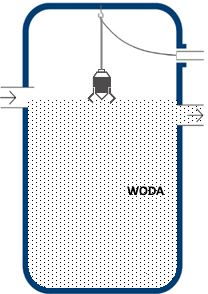
where:
Poziom pomiaru = measurement level
Woda = water
Fill the tank with water up to the overflow level on the drain. In the upper part of the tank, attach the NFIX-1 mounting bracket. The probe should be hung at a height corresponding to the maximum level of the liquid surface.
- oil level - Oil, fat, petroleum derivatives (OILER) probe, 5 m cable
Conductometric probe (an insulated electrode equipped with a mechanical connector that allows it to be attached to the object), is used in fat, oil and petroleum separators to measure the thickness of the layer of oil, fat and petroleum substances.


where:
górna elektroda = upper electrode
punkt pomiarowy = measuring point
dolna elektroda = lower electrode
tłuszcz olej = fat
osad = sediment
- sludge level in the separator - Sludge probe (SULDO), 5 m cable
The probe is used in oil, fat and petroleum separators. It is responsible for measuring the thickness of the sediment using the ultrasonic measuring system located in its lower part. Due to a change in signal strength caused by a change in the environment.
The probe informs about:
- normal condition (immersed in water)
- in alarm condition (immersed in sediment)
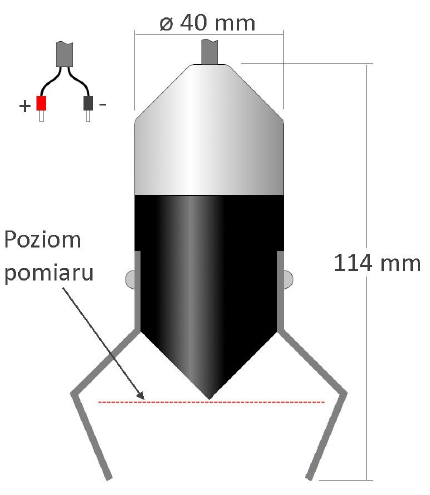
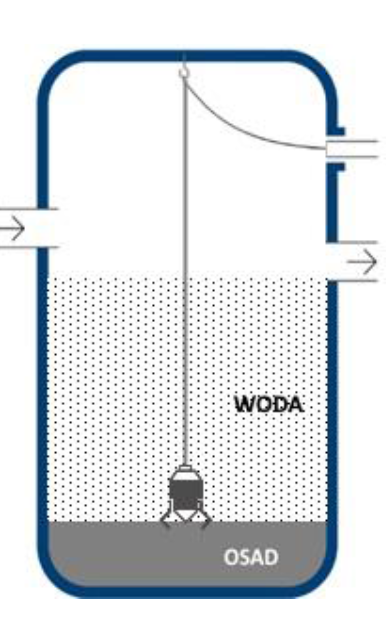
where:
- Poziom pomiaru = measurement level
Woda = water
Osad = sediment
The sensor is placed at the bottom of the probe so that the measurement level corresponds to the height of the top of the sludge layer. Fill the tank with water to the overflow level on the drain.
3. Alarm modules - controllers
SQUEALER is an alarm module for separators used to measure and control the level of the oil layer, sediment, and overfilling the tank.
Powered by 230V. Microprocessor for controlling the probes (MAX, OILER, SLUDO)
- SQUEALER-1
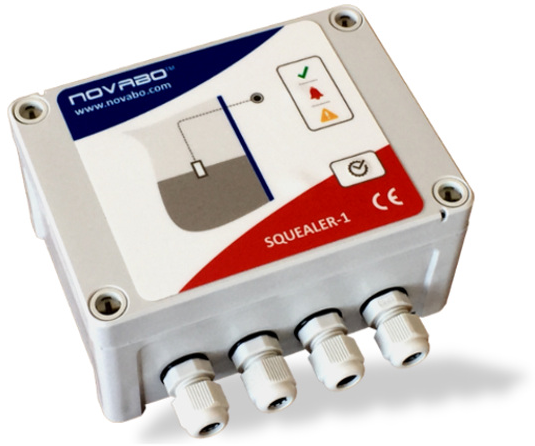
- 1 input (overfill, level of fat, grease, oil, sludge level)
- 1 tamper zone
- 1 output (potential-free, relay)
- 230V
- hermetic housing
- DIPSWITCH (programming via switches)
- optical and acoustic signaling of alarms and input failures (LED, BUZER)
- diagnostics of sensors / installations (short circuit opening in the circuit)
- SQUEALER-2
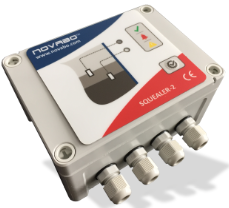
- 2 inputs (overfill, level of fat, grease, oil, sludge level)
- 1 output (potential-free, relay)
- 230V
- DIPSWITCH (programming via switches)
- optical and acoustic signaling of alarms and input failures (LED, BUZER)
- diagnostics of sensors / installations (short circuit opening in the circuit)
- SQUEALER-3
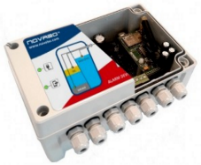
- 3 inputs (overfill, level of fat, grease, oil, sludge level)
- 3 outputs (potential-free, relay)
- 230V, emergency power supply (battery)
- battery input
- DIPSWITCH (programming with switches, programmable reaction time to signals from sensors)
- SQUEALER-GSM
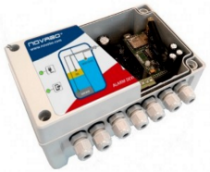
- 2 outputs (potential-free, relay)
- GSM (SMS, system status on demand, battery status notification)
- 230V, emergency power supply (battery)
- USB (programming, reading memory of 256 events)
- battery input
- SQUEALER-WRL
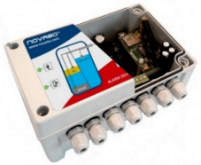
- 3 inputs (overfill, level of fat, grease, oil, sludge level)
- 1 output (potential-free, relay)
- GSM (SMS, system status on demand, battery status notification)
- battery powered
- solar power
- USB
Monitoring the level of oil derivatives and fatty substances is acoustically and visually thanks to the built-in LED diodes. Special built-in sensors make it possible to recognize the thickness of the liquid in the separator. Sensors distinguish water from light liquids, grease or oil as well as monitor their decline.
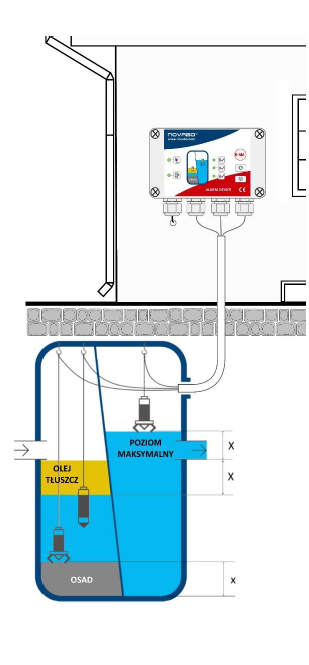
where:
olej tłuszcz = oil, fat
poziom maksymalny = maximum level
osad = sediment
4. Sets - various application configurations
The possible configurations of the probe application depending on the controlled substance are presented below.
- Measurement of fat, oil and petroleum substances
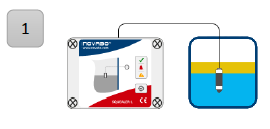
1 x SQUALER-1 (controller)
1 x OILER (PROBE FOR FAT, OIL, PETROLEUM)
- Overflow measurement
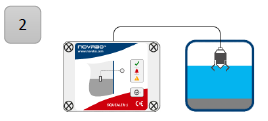
1 x SQUALER-1 (controller)
1 x SULDO (MAX sediment probe)
- Measurement of the sediment layer
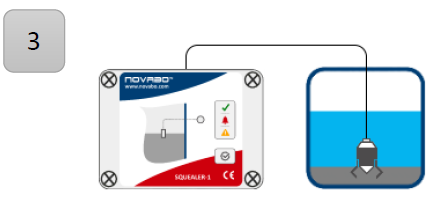
1 x SQUALER-1 (controller)
1 x SULDO (MAX sediment probe)
- Overfill and fat layer thickness measurement

1 x SQUALER -2 / -3 / -GSM / -WRL (controller)*
1 x SULDO (MAX sediment probe)
1 x OILER (fat, oil, petroleum substance probe)
- Thickness measurement of the fat layer and the sediment layer
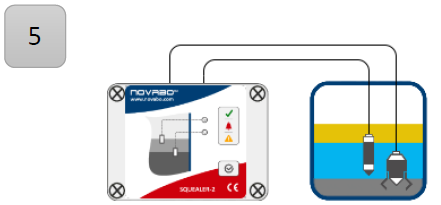
1 x SQUALER -2 / -3 / -GSM / -WRL (controller)*
1 x SULDO (sediment probe)
1 x OILER (fat, oil, petroleum substance probe)
- Measure overfill and sludge thickness

1 x SQUALER -2 / -3 / -GSM / -WRL (controller)*
1 x SULDO (MAX sediment probe)
1 x SULDO (sediment probe)
- Overfill, fat layer and sludge layer measurement
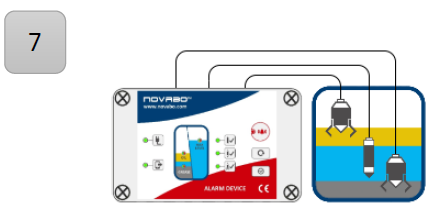
1 x SQUALER -3 / -GSM / -WRL (controller)*
1 x SULDO (MAX sediment probe)
1 x OILER (probe for fat, oil, petroleum substances)
1 x SULDO (sediment probe)
* You can choose the SQUEALER-2, SQUEALER-3 controller, powered by 230 V, SQUEALER-GSM with a GSM module, or SQUEALER-WRL wireless, battery powered with a GSM module.
5. Step-by-step commissioning
1. Fill the separator with water until overflow from the drain
2. Place the probe at the depth corresponding to the thickness of the monitored layer (100 mm for an oil derivative)
3. Attach the probe to the mounting ear
4. In the case of extension of the probe cable, mount its end in the connecting sleeve that connects the probe with the controller
The probe measuring element is placed on the upper junction of the metal and non-metal parts. The alarm will go off when there is a change in the environmental phase - ie from water to oil, grease or from water to air.
6. Controls and reviews
The inspection is performed every 6 months or every time the separator is emptied. The probe (OILER, SLUDO or MAX) should be cleaned and checked if it is compatible with the SQEALER.
7. A way to deal with unpleasant odors
In case of unpleasant odors, we would also like to offer you ventilation anti-odor filters.
The role of the odor absorber is played by impregnated activated carbon, improving the comfort of use of sewage systems.
8. Additional equipment for separators
The separators are equipped with suction valves as well as automatic lid closing systems, preventing harmful and petroleum derivatives from escaping into the sewage system as a result of maximum filling with oil. The operating scheme is based on the work of a float, placed in a pipe filled with water. When the maximum amount of oil is reached, it goes to the side drains of the separator. The float drops down, closing the drain of the separator.
In summary, the alarms are used to monitor petroleum substances (oil and sludge level, overfill sensor). The system is designed to control overfilling, lower or increase the liquid level in the separator. Possible causes could be: leak detection of the separator, blockage of the filter or the outlet by a float.

Comments (0)